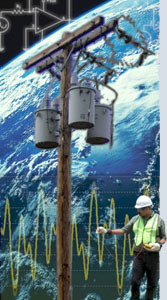Using Grounding Rings around Swimming Pools to Mitigate Neutral-to-Earth Voltage
Introduction
In 2009, EPRI evaluated grounding rings around swimming pools to determine whether or not they can mitigate neutral-to-earth voltage (NEV) and the associated perceptible currents that result in pool and spa complaints. In 2008 and 2009, EPRI constructed a selection of test structures suitable for conducting comprehensive NEV assessments at EPRI’s Lenox Test Facility.
Swimming Pool Setup
Figures 1 and 2 provide a useful visual understanding of the mitigation test capabilities at the Lenox swimming pool test structure. The idea is to be able to test different deck compositions, including:
- Properly installed and bonded concrete with reinforced wire mesh (the NEC article 680 equipotential grid)
- Concrete decking with no reinforcing wire mesh (the source of most pool shocking complaints)
- Concrete decking with no reinforcing wire mesh, but ability to overlay a conductive surface coating and bond that surface to the rest of the grounding system and the pool water
- Decorative brick pavers with no reinforcing wire mesh
 |
| Figure 1: Swimming Pool Test Structure |
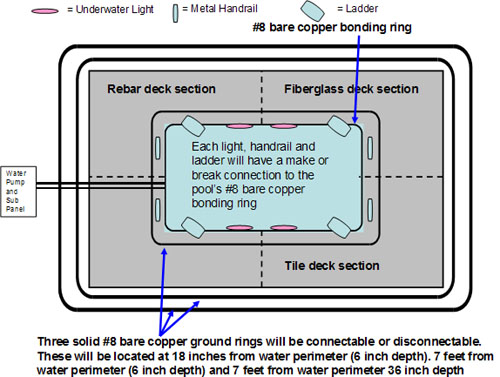 |
| Figure 2: Conceptual Plan for Wet Area Test Structure at the Lenox Test Facility |
The pool test structure is also constructed with ground rods and bare copper ground rings that can be connected or disconnected via a selection of knife switches.
Mitigation Testing with Incomplete Deck Sections
Once the pool was constructed and the wiring and connections all confirmed, a series of tests was undertaken to determine the performance of each of the respective mitigation options with the deck sections left undone. As shown in Figure 3, there is a purple line that indicates the location of a supplemental grounding and bonding wire where that section will be connectable and disconnectable from the concrete decks sections. This supplemental grounding connection is in contact with the cement, unlike the other inner ground ring, which is buried about six inches down into dirt.
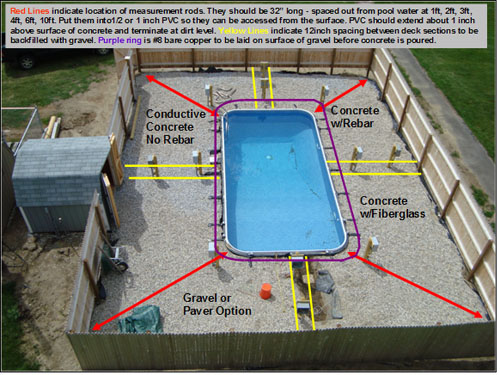 |
| Figure 3: Deck Section Layout |
To evaluate the natural NEV scenario, the overhead distribution line was configured as a 480-volt feed, and a switchable heater load bank was used to load up the circuit. The 480-volt configuration effectively multiplies the current on the neutral by a factor of nine as compared to the normal 4,160-volt configuration, and adding a few ohms of variable neutral resistance with the rheostat enables significant neutral-to-earth voltage for testing purposes.
As an initial test condition, the load on the neutral was increased until a voltage potential of 2.0 VAC was measurable between the pool water and a ground rod located one foot away from the water, as measured with a 500-ohm load resistor. Measurements were then taken at 2 ft, 3 ft, 4 ft, 6 ft, and 8 ft from the water—for every combination of bonding and/or grounding ring and ground rod.
Next, the circuit was loaded until the voltage one foot from the pool water measured 5.0 VAC, and the measurements were all repeated. Finally, the circuit loading was increased to achieve 8.0 VAC between the pool water and the one-foot mark. In total, over 500 individual measurements were taken to understand the mitigation opportunities afforded by the various ground-rod and grounding-ring configurations. Just to confirm the accuracy of the measurements to the ground rods, several spot checks were made with a 12 in. by 12 in. steel plate, which confirmed that both the steel plate and the ground rod provide an accurate measurement.
Mitigation Testing with Complete Deck Sections
Once all of the deck sections were completed, the tests described under “Mitigation Testing with Incomplete Deck Sections” were all repeated, with the only exception being the that the new test points focused on the concrete surface instead of the ground rods connected to the earth. The additional mitigation options that were evaluated included a grounding ring positioned about 18 inches from the pool water and in contact with the cement deck, shown as the purple ring in Figure 3, and a second ground ring buried just beyond the cement decking two feet down into the earth.
Significant Findings from the Ground-Ring Mitigation Tests
Bonded rebar or reinforcing wire in the concrete is by far the best option for mitigation of contact voltage potentials around a swimming pool or spa. The best option for mitigation at a pool where there is no steel reinforcing mesh in the concrete is a double ground ring configuration. With the double ring configuration, one of the rings is positioned about 18 inches from the pool water and is in contact with the cement deck (not in the dirt below the cement). The second ring is buried just beyond the cement decking (at least two feet down into the earth). When these two rings include supplemental ground rods, the performance is even better.
The second best option for mitigation at a pool where there is no steel reinforcing mesh in the concrete is a single ground ring configuration just beyond the cement decking and at least two feet down into the earth, as shown in Figure 4. When a single ring includes supplemental (eight-foot long) ground rods driven vertically into the soil at a 16-foot distance, the effect is even better. An outer ground ring reduces the voltage around the pool area by 50% to 60%, and each ground rod adds another 1% for a maximum of 70% reduction (5 VAC at 1 foot reduces to 1.5 VAC). As shown in Figure 5, a horseshoe configuration works well for NEV (approx 5% less effective than a full ring!) but does not help on the side where the horseshoe does not come around.
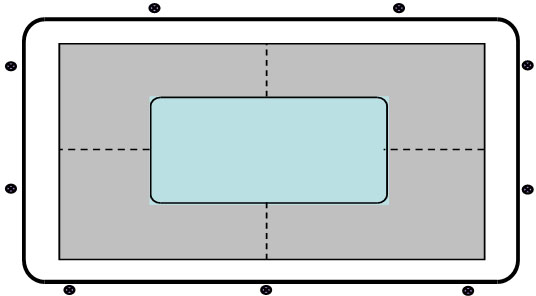 |
| Figure 4: Outer Ground Ring to Reduce Voltage around Pool Area |
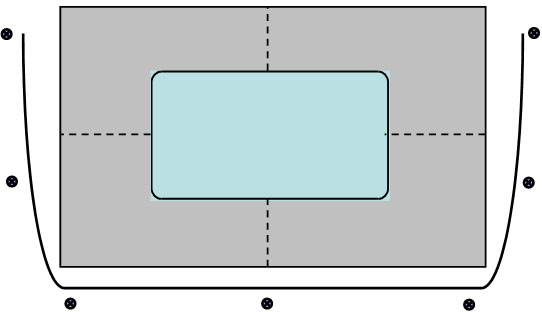 |
| Figure 5: A Horseshoe Configuration of a Ground Ring |
As shown in Figure 6, two outer ground rings buried 8 feet from the pool edge at 6 inches (depth) and 3 feet (depth) adds another 6% to 16% improvement compared to just one ring (deeper rod is better).
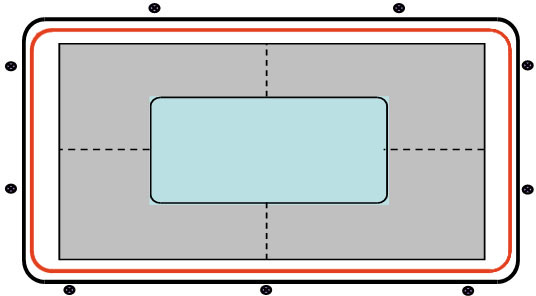 |
| Figure 6: Two Outer Ground Rings Buried 8 Feet from Pool Edge at 6 Inches and 3 Feet Deep |
